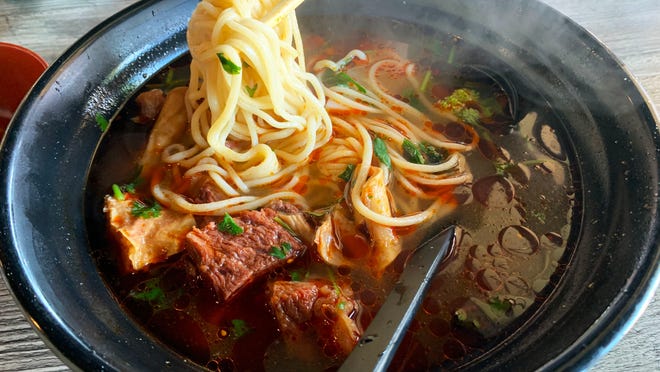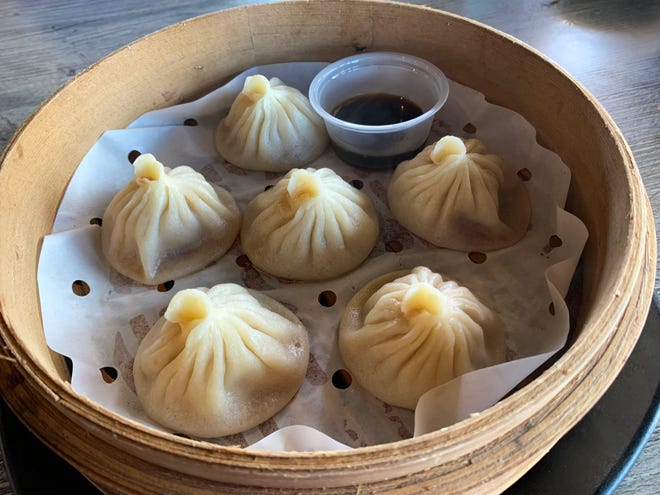Lanzhou beef noodle soup at Kungfu Ramen

There was something about the words “Kungfu” and “Ramen” that didn’t track. Chinese martial artists selling Japanese noodle soup? I circled around the parking lot for a closer look at the colorful food photos posted on the front window of the Tempe restaurant. In between xiaolongbao soup dumplings and a chile glazed platter of cumin beef, there was photo after photo of glistening Chinese soups showcasing epic noodle pulls.
“Hand-pulled ramen. Famous chef from D.C.,” the sign outside Kungfu Ramen read.
A man wearing a white chef’s cap was pictured in front of another restaurant, Lanzhou Hand Pull Noodle, located in a Maryland suburb of Washington D.C. In 2019, the restaurant was written up in the Washington Post for its faithful renditions of a Muslim Chinese noodle soup, ubiquitous across China but relatively unknown in the United States. “The yellow noodles were hothouse flowers, soft and retreating. They almost dissolved on contact with the tongue …” the article by Tim Carman read.
I walked inside and found the chef from the picture standing behind a tall window panel. He teased, stretched and tossed a mound of dough into thin golden strands of lamian noodles the size of his outstretched arms, and then plopped them into a vat of boiling water.
What are lamian noodles?
Neither the restaurant in Washington D.C., nor Kungfu Ramen actually serve “ramen,” but the noodles they do serve have a similar linguistic origin. In Mandarin, the word lamian refers to hand-stretched wheat noodles, usually long and thin with a pronounced chewiness. In fact, the Japanese ra,men we know and love were brought to Japan by Chinese immigrants in the mid-1800s.
One of the most popular lamian dishes is Lanzhou noodle soup, originally made by the Hui Muslim people of Northwestern China, and now a regular presence in noodle shops across China. The soup is known for the clarity and crispness of its beef broth, which contains a healthy layer of chile oil that floats atop the noodles, white daikon radishes and greens.
Kungfu Ramen serves Lanzhou lamian soup, customizable with eight different varieties of hand-pulled and knife-cut noodles that range in thickness from thin to extra wide. There are several different broths on the menu as well, including spicy and braised soups plus tomato beef and tomato beef brisket.
The options can be dizzying, so much so that after two visits I feel I’ve barely scratched the surface. A good go-to order is the standard Lanzhou noodle soup with regular-sized noodles. It’s a nice introduction to the style of soup and noodle. After you’ve tried it, I’m confident you’ll understand the appeal.

What does Lanzhou noodle soup taste like?
The light beef broth of my Lanzhou noodle soup didn’t have the potency or the sizzle of its Sichuan beef noodle soup counterparts. Instead, it was delicate and aromatic, and despite its glimmer of chile oil, I was tempted to add more of the stuff from the plastic tub on the table. The wheat noodles themselves were the highlight—thin, slippery and extremely long, they tasted almost like freshly-made spaghetti. They were not curly, but easily twirled when I twisted them up into my chopsticks for a long, messy slurp.
Around the noodles were bits of beautifully fatty brisket, some of the best I’ve had in any Chinese soup. Curled-up beef tendons, with their slippery hint of offal, added a meaty flavor. Slices of daikon and steamed broccoli added freshness.
What to order at Kungfu Ramen

Handmade knife-cut noodles are a pretty hard thing to find in the Valley, and Kungfu Ramen serves a doughy version that are worth seeking out. The noodles taper off on the edges until the faint white color becomes almost translucent. They arrived in the shop’s golden signature broth along with plump shavings of sliced lamb. They’re good, but I would stick to the hand-pulled varieties here, because they have more finesse.
Another way to enjoy the hand-pulled noodles is in a stir fry, which is equally as satisfying as the soup. I ordered mine “dry” rather than “sauce-mixed,” yet the noodles and sliced vegetables still had a good amount of wetness to them and came paired with fatty beef brisket rather than a stir-fried meat.
And, while you’re there, don’t pass up an order of better-than-average dumplings, which include some seriously hefty xiaolongbao soup dumplings that are prone to squirting their searing hot meat broth if you’re not careful. The steamed pork dumplings were also a highlight, as they were hearty and not too doughy. As the weather cools down, Kungfu Ramen is a unique noodle shop that really hits the spot.

Kungfu Ramen
Where: 1845 E. Broadway Road, Unit 127, Tempe.
Hours: 11 a.m. to 10 p.m. daily
Price: Cold plates $4.99-$8.99; buns and dumplings $5.99-$9.99; noodle soups and stir fries $10.99-$11.99.
Details: 480-268-7331, phoenixramen.com.
Reach dining critic Andi Berlin at [email protected]. Follow her on Facebook @andiberlin, Instagram @andiberlin or Twitter @andiberlin.







